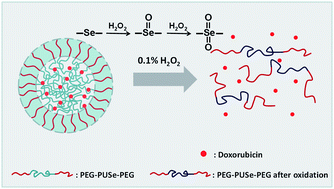Ning Ma, Ying Li, Huifeng Ren, Huaping Xu, Zhibo Li, and Xi Zhang
Polym. Chem., 2010, 1, 1609-1614.
A selenium-containing amphiphilic block copolymer (PEG-PUSe-PEG) with a hydrophobic polyselenide block and two hydrophilic poly(ethylene glycol) (PEG) blocks was synthesized via polymerization of toluene diisocyanate (TDI) with monoselenide-containing diols and subsequent termination with PEG monomethylether. PEG-PUSe-PEG is able to self-assemble in aqueous solution to form block copolymer aggregates. Interestingly, it was found that the aggregates have a good oxidation-responsiveness and undergo a structural dissociation in a mild oxidative environment (such as 0.1% H2O2 v/v) due to the unique sensitivity of selenidegroups in presence of oxidants. Compared with the sulfide analogue PEG-PUS-PEG, PEG-PUSe-PEG is more sensitive to oxidants. It is anticipated that selenium-containing block copolymer aggregates may find application in the field of drug delivery systems.

